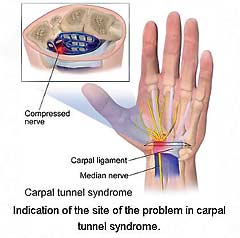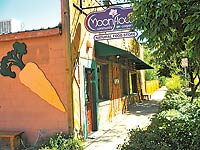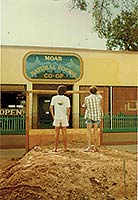|
|
HEALTHY HAPPENING August 2019
|
Carpal Tunnel Syndrome:
What the Tingling and Numbness Means
|
 What Is It? What Is It?
Carpal Tunnel Syndrome is a common hand condition causing pain, numbness, tingling, and/or prickling sensations in the hand and wrist. If you find yourself “shaking your hands out” to regain normal feeling in your hands during the day, (or in the middle of the night, or while you are driving, or doing other common daily tasks), you may be developing carpal tunnel syndrome. The tingling sensation in the hands (specifically in the thumb, index and middle fingers) is a result of too much pressure on a major nerve deep in the wrist. The carpal tunnel is a tunnel in the wrist that contains this nerve along with nine other tendons, all traveling from the forearm down into the hand. If this nerve gets compressed for an extended amount of time (a situation that can be caused by irritation or swelling inside the tunnel) it sends tingling, prickling and/or numbness into the fingers and hand. If it’s not treated it may get worse over time; the numbness/prickling gets more intense, muscle strength in the hand gets weaker, and eventually it can lead to permanent damage of nerves and key muscles in the hand.
Often, carpal tunnel syndrome gets worse at night due to poor sleep positions of the hand. It can also occur during daily tasks that require prolonged gripping; such as driving, holding a book, or holding a phone to text or make a call. Symptoms can become noticeable during any activity and you may find yourself frequently starting to drop things as the syndrome progresses.
What Can Be Done?
Most people know someone who has received carpal tunnel surgery and may fear that it is the only treatment option; but new hand therapy treatments have been developed that can help someone heal from carpal tunnel syndrome, and most people opt to try the non-surgery methods first. Though it is true that some cases are so severe that surgery is the best option, with the right treatment, most people can heal without it.
Elynn Schriber MOTR/L specializes in Hand Therapy right here in Moab. She is an Occupational Therapist (OT) who provides Hand Therapy at the Precision Rehabilitation clinic located at 1030 Bowling Alley Lane. In addition to carpal tunnel syndrome she is trained in treating many other common conditions and injuries of the hand and elbow.
Precision Rehabilitation accepts most insurances. Cash pay also available. Some insurance companies allow Occupational Therapy visits without a doctor referral. If your insurance requires one, simply ask that an ‘OT Hand Therapy’ referral be sent to Precision Rehab while at your next doctor visit.
Call (435) 355-0126 to schedule a visit, , or call with questions, we are happy to help you.
|
Core Training and Back Pain |
You have probably heard that having a strong core is important and helps with back pain, athletic performance, injury prevention, posture and the various activities of daily living. Unfortunately, many people practice core exercises without regard for alignment or breathing patterns. Abdominal crunches, planks and the bird dog exercise build muscle, but when they’re done incorrectly, they can lead to further weakness.
 The problem is overextension of the spine, forward rotation of the pelvis, and breath holding when doing core exercises. This misalignment can be seen in the photo. If the goal of core training is to reduce back pain through development of a balanced, strong torso with an aligned spine and symmetrical pelvis, strengthening this misaligned position is counter to that objective. The problem is overextension of the spine, forward rotation of the pelvis, and breath holding when doing core exercises. This misalignment can be seen in the photo. If the goal of core training is to reduce back pain through development of a balanced, strong torso with an aligned spine and symmetrical pelvis, strengthening this misaligned position is counter to that objective.
A stable, aligned pelvis is the foundation of a strong core. Located at the base of the spine, the pelvis links the upper and lower body and performs the dual roles of stabilization and motion generation. It supports the weight of the upper body when sitting or standing and transfers power from the core to the limbs during movement.
As a posture therapist, many of my clients suffer from back pain when sitting or standing still for a long time. In these cases, their static posture resembles the position shown in the photo. When the pelvis is no longer aligned, providing a solid base to hold the upper body, the soft tissues along the spine take on this supportive role.
We are all under the constant, unrelenting force of gravity as it pushes down on our bodies continuously. In ideal alignment, the force of gravity is transferred down the vertebrae of the spine and bones of the pelvis. However, when the posture of the vertebrae and pelvis are misaligned, the downward force of gravity is passed through the soft tissues. With time, this can over stress your muscles, tendons, ligaments and fascia, which can cause strain, breakdown and pain, commonly in the lower back.
What exercises should you do to strengthen your core?
Although commonly advised, abdominal and lower back exercises are not enough to keep your core strong. As discussed, the position of the spine and pelvis are fundamental to a strong core. Keeping the pelvis in an aligned position requires a coordinated effort among the muscles that are attached to it from all directions. The abdominal and lower back muscles attach to the pelvis from above. Yet, there are also many muscles attached to the pelvis from below and at the sides. Your core training program should incorporate exercises for all of these muscles, including the inner and outer thigh, quadriceps and hamstrings, hip rotators, gluteals, and hip flexors.
Most importantly, to train the core correctly and reduce back pain, the body needs to be in alignment. The rib cage and pelvis need to be stacked with the spine elongated. This is facilitated and maintained through efficient breathing and fluid movement of the respiratory diaphragm and pelvic floor with each inhale and exhale.
Learn more! Here are two options to discover effective training exercises. First, sign-up for The Core Challenge, and receive core alignment and strengthening tips delivered to your email inbox over five days. thepfathlete.com/core. Second, attend the Posture Fitness Class. See the ad on this page for further information.
Jessica Kisiel, MS, is a local wellness professional specializing in injury recovery and pain management through alignment. She is certified by the Postural Restoration Institute®, Egoscue University®, NSCA, ACSM, ACE and Wellcoaches.
|
| The Phase of the Moon |
This month, Moonflower Community Cooperative celebrates four decades as Moab’s source of holistic community wellness. Moonflower originally took root as Lifestream, a natural foods-buying club established in 1975 by Conrad Sorensen. This became the Moab Community Cooperative in 1979, which served as a space to share ideas, provide healthy, sustainable natural foods, and host art exhibits, educational activities, and spontaneous concerts.
Twenty years later, Conrad passed the torch to four dedicated community members to carry on his legacy. They went to work developing the by-laws that would create Moonflower Market. In August 2013, after years of research and exploration, Moonflower Market filed Articles of Restatement to become Moonflower Community Cooperative, Utah’s first member-owned food cooperative.
Moonflower has seen several expansions and remodels, from its original wooden ammo box construction on 100 West to its current location at 39 East 100 North, and several iterations of management. Today, the co-op continues to grow as demand has increased. Despite many changes, Moonflower has held true to its mission of providing “socially responsible foods, goods and education to promote a healthy, sustainable community.”
That Moonflower has remained such a cornerstone of Moab throughout the decades is a testament to the importance of community. At Moonflower, one can interact with friends, strangers, locals, visitors, farmers who grow their produce, the staff who make the delicious Datura Deli offerings, teachers of the free classes held every month, and people from many different walks of life. Here you can make connections that build a vibrant, resilient social network.
 Being a member-owned cooperative ensures that this unique business sustain its mission of serving owners and maintaining that sense of community. The cooperative business model keeps money local rather than benefiting a large corporate entity. Profits are reallocated to owners when they are sufficient, and the co-op supports local and regional farmers and craftspeople who make their living by producing healthy, sustainable foods and merchandise. Owners also contribute to managing the co-op through a representative democracy. They can run and vote for a board of directors that guides the long-term vision of the co-op and vote on the co-op’s by-laws. Being a member-owned cooperative ensures that this unique business sustain its mission of serving owners and maintaining that sense of community. The cooperative business model keeps money local rather than benefiting a large corporate entity. Profits are reallocated to owners when they are sufficient, and the co-op supports local and regional farmers and craftspeople who make their living by producing healthy, sustainable foods and merchandise. Owners also contribute to managing the co-op through a representative democracy. They can run and vote for a board of directors that guides the long-term vision of the co-op and vote on the co-op’s by-laws.
Owners, locals, and visitors can celebrate the spirit of cooperatives and Moonflower’s colorful history on Saturday, August 10th at The Phase of the Moon, its anniversary celebration and annual owner meeting. During the anniversary celebration from 11am-4pm, all will have the opportunity to meet local and regional vendors and sample their products. Owners will receive 15% off all local and regional products all day! At the annual meeting to follow, the general manager and board of directors will give an update and announce the newly elected board directors. At 5pm, the entire community is invited to a delicious dinner made by special guest chefs featuring local and regional produce!
Help Moonflower celebrate the past several decades of evolution as Moab’s beloved community hub and plan for the next 40 years and beyond!
|
| Grand County Hospice Recognized as a We Honor Veterans Partner |
It may surprise many people to learn that 25 percent of those who die every year in the U.S. are Veterans. To help provide care and support that reflect the important contributions made by these men and women, Grand County Hospice has become a national partner of We Honor Veterans, a pioneering campaign developed by National Hospice and Palliative Care Organization in collaboration with the Department of Veterans Affairs. 
As a We Honor Veterans partner, Grand County Hospice will implement ongoing Veteran-centered education for their staff and volunteers to help improve the care they provide to the Veterans they proudly serve. The nation is seeing many of the Veterans who served in World War II and Korea pass away—and the number of deaths of Vietnam Veterans is beginning to rise.
The We Honor Veterans campaign provides tiered recognition to organizations that demonstrate a systematic commitment to improving care for Veterans. “Partners” can assess their ability to serve Veterans and, using resources provided as part of the campaign, integrate best practices for providing end-of-life care to Veterans into their organization. By recognizing the unique needs of our nation’s Veterans who are facing a life-limiting illness, Grand County Hospice is better able to accompany and guide Veterans and their families toward a more peaceful ending. And in cases where there might be some specific needs related to the Veteran’s military service, combat experience or other traumatic events, Grand County Hospice will find tools to help support those they are caring for..jpg)
“We thank Grand County Hospice for partnering in the We Honor Veterans program,” says NHPCO President & CEO Edo Banach. “We Honor Veterans partners are committed to providing quality Veteran-centric care to the Veteran patients they serve. They understand how a Veteran’s military service, combat experience or other traumatic events, could impact their end-of-life experience.”
The resources of We Honor Veterans focus on respectful inquiry, compassionate listening, and grateful acknowledgment, coupled with Veteran-centric education of health care staff caring for Veterans. “VA shares a common goal with our nation’s hospices, and that is to provide the best possible care specifically tailored for Veterans, meeting their goals of care in their preferred setting. As we focus on working together and unite our services and skills, We Honor Veterans will channel our combined strengths directly to Veterans - wherever they are receiving care,” added Banach.
To start things off right, Grand County Hospice hosted a regional training delivered by the VA Western Colorado Health Care System, addressing the end-of-life care needs of the Vietnam Veteran. Mary Jo Hughes, Hospice and Palliative Care Program Manager, Dr. Terrance Coombs, Palliative Care Psychologist and Charles Grimsley, VA Chaplain, provided the training specific to PTSD, Moral Injury and Suicide. Local organization representatives in attendance were from Moab Regional Hospital, Canyonlands Care Center and Community Nursing Services.
To learn more about Grand County Hospice or to support our local, community-driven mission through a donation, please contact Jessica Walsh at (435)719-3772.
|
HEALTHY CLASSES
Tuesdays
Sheng Zhen Tuesdays with Lisa- two meditation forms from 1:-1:45 seated from a chair and a standing form taught from 2:00-3:00 pm at the Grand Center Vitality Room at 182 North 500 West. Contact certified teacher, Lisa DeRees 435-260-9678 for details. No class on July 16th.
Kundalini Yoga & Gong Meditation- 5:30pm at 125 E. 200 North, Historic Helen Taylor Home. Teacher: Gregory Lee Hood. By donation. For info: 713-817-7859.
Wednesdays
Yoga Basics- 11:30-12:45pm at Moab Recreation & Aquatic Center, 374 N Park Ave. Props available. Drop-in prices. Donation based for AARP Medicare Sup, SilverSneaker, Fit members. Questions? Contact Star Kolb mindivine@gmail.com 406-291-6408
Thursdays
All Levels Sheng Zhen Gong – every Thursday 5:30-7pm with certified teacher Don Leathers at the Moab Arts & Recreation, 111 E. 100 North. 435-259-8123.
Kundalini Yoga & Gong Meditation- 5:30pm at 125 E. 200 North, Historic Helen Taylor Home. Teacher: Gregory Lee Hood & Music Sound Therapist Annette Kearl, PhD. By donation. For info: 713-817-7859.
Saturdays
10am Kundalini Yoga & Gong Meditation at 2950 Red Moon Lodge, Old City Park Road. Teacher: Gregory Lee Hood & Music Sound Therapist Annette Kearl, PhD. By donation. For info: 713-817-7859 |
|
| |
|
|
|
|
|
|
© 2002-2024 Moab Happenings. All rights
reserved.
Reproduction of information contained in this site is
expressly prohibited.
|
|